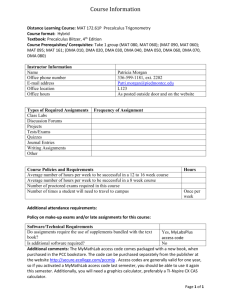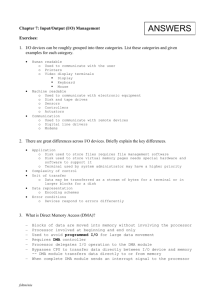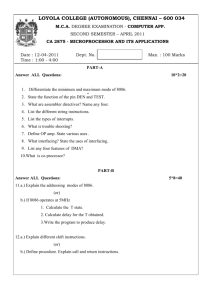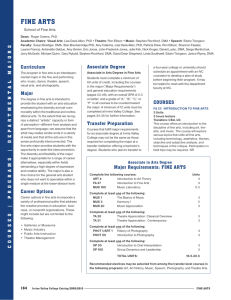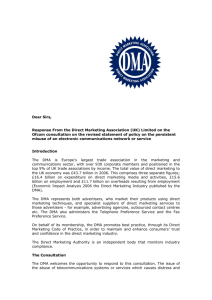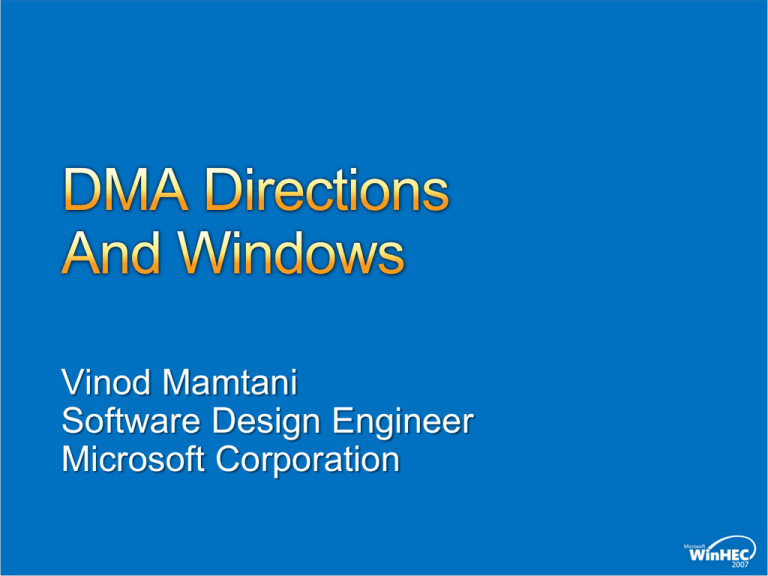
Vinod Mamtani
Software Design Engineer
Microsoft Corporation
DMA Support in Windows
Windows DMA APIs
Platform Advancements
DMA Remapping
Driver Considerations
Feedback Solicitation
Types of DMA devices
Bus-master device
System DMA controller that manages DMA
channels on behalf of I/O devices
Types of DMA transfers
Common buffer DMA
Packet-based DMA
Windows supports cache coherent
DMA transfers
Map registers
Fundamental abstraction for DMA
Used for aliasing device address space
to system memory
Represent translation entries for pages of
DMA transactions in flight
Abstract double buffering that may be
implemented by the system
Abstract device and platform capabilities
Abstraction with map registers
On most platforms today the device address
space is same as the physical (system) address
space
Virtual Address Space
MDL
Map Register 2
Map Register 1
Map Register 0
PA
VA
Device
Address Space
Physical Address Space
Map registers
Required for devices that need to access
memory outside their addressability
range
Required for devices that do not
implement scatter-gather capabilities
Map registers are shared system
resources
Available with system DMA APIs or
kernel mode driver framework (KMDF)
Architectural strengths
Designed to support a variety of
architectures: MIPS, Alpha, x86,
x64, Itanium
Suitable for different classes of devices
and transfer types
Driver programming is simplified with
abstraction of device capabilities relative
to the platform
Optimized for highly capable devices
Architectural strengths
Guarantees forward progress on
x64 platforms
Supports asynchronous APIs
Scaled well with the evolution of devices
in the last two decades
Shortcomings of hardware support
There is no mechanism for a driver to
accurately describe its device transfer
capabilities to the DMA subsystem
Device addressability can only be
expressed in terms of 24, 32 or 64-bit
granularity
The number and size of scatter-gather
segments cannot be expressed
Isochronous DMA transfers are
not supported
Shortcomings of the programming model
A driver may be allotted fewer map
registers forcing it to split its DMA
transfers
Adds complexity and poses difficulty in
testing all corner cases
Map register allocation is queue-based
and has a callback model
Inability to perform DMA-related actions
in parallel
Shortcomings of the programming model
Support for user mode DMA isn’t
complete
Driver is responsible for the
synchronization of requests that occur on
different processors
Chained MDLs for virtually discontiguous
buffers are not supported
Factors driving reassessment of DMA
support
Devices
Bus-master DMA is the norm
Transfer sizes have increased
Scatter-gather capabilities are common
Addressability range has increased
Chipset
Virtualization of I/O
System
Larger amounts of memory
Address space below 4GB is constrained
I/O Virtualization
Intel has published VT-d(2)
specifications and AMD has
published IOMMU specifications
Commonly called “DMA Remapping”
(DMAr) within Microsoft
Hardware support for controlling
individual device access to physical
memory
Typically a function of the north bridge
or chipset
I/O Virtualization
Control of device access and translation
of DMA requests
Can be used in both the virtualized and
non-virtualized Operating System (OS)
Supports interrupt remapping
Enables/assists device assignment
Hardware support for DMA memory
management
Page attributes are read, write or read-write
Demand paging not supported
Support is absent in the device protocols
Support is absent in the Windows Driver Model (WDM)
Requires valid mappings to system memory
before the transfer is issued on the bus
DMA
I/O Devices
Source: Intel Corporation
DMA
Remapping
CPU Access
Physical Memory
CPU Memory
Virtualization
Processors
Intel VT-d(2) topology
Processor
Processor
System
Bus
Memory
North Bridge
VT-d(2)
Integrated
Devices
PCI
Express
Root Ports
PCI Express
Devices
Source: Intel Corporation
South
Bridge
PCI, LPC,
Legacy
Devices
DRAM
Source: AMD
HT Link
PCI
Express
Bridge
I/O Hub
PCI, LPC,
Legacy
Devices
PCI
Express
Devices
ATC
CPU
HT Link
PCI
Express
Bridge
PCI
Express
Bridge
IOTLB
CPU
Tunnel
IOMMU
DRAM
IOMMU
IOTLB
AMD IOMMU topology
PCI
Express
Device
Domain Mapping Tables
Identifies the domain and associated address
translation tables for a requestor ID
Address Translation Tables
Used to translate the addresses of all DMA requests
for a device
Hardware Caches
Cache entries from the domain mapping and address
translation tables
Device IOTLB
Remote cache of table entries in a capable device
Requester ID
15
8
Bus
7
DMA Address
3 2
Dev
0
63
39 38
30 29
21 20
12 11
0
Fn
9
9
9
Bus 255
Dev 31 Fn 7
Bus B
Dev D Fn F
Bus 0
Root Entry
Table
Address Translation Tables
Dev 0 Fn 0
Context Entry
Table
Domain Mapping Tables
System
Memory
Source: Intel Corporation
12
DMA Address
63
58 57
000000b
48 47
000000000b
39 38
Level-4 Offset
9
30 29
00000000b
Level-4 Table
0
21 20
Level-2 Offset
9
Physical Page Offset
Level-2 Table
2 MB Page
21
Physical Address
52
52
PDE
63
2
PDE
52 51
12 11
Level-4 Page Table Address
Source: AMD
0
9 8
4h
0
Domains
Domain is an abstract, isolated environment
Each device is assigned exactly one domain
Devices have visibility into memory mapped to a domain
A DMAr unit can support multiple domains
Domain mapping tables can be shared by multiple
DMAr units
Address translation tables can be shared across domains
A domain supports abstraction of a device address space
A device address is mapped with appropriate
read-write permissions
Future directions
DMA Remapping Use Cases
Long term technology plan not set in
stone
Use cases
Improve system robustness and reliability
Catch potential DMA corruptions
Protect system code and data structures
Report hardware faults to
management software
Provide device scalability solutions
Eliminate bounce buffers
Device isolation
Protected mapping
Each device may have
a unique DMA
address space up to
its highest supported
address
Device addresses are
dynamically mapped
and unmapped using
DMA APIs
Maximizes device
isolation, providing the
most containment
Mapped
Mapped
Device
Address
Space
System
Address Space
Protected Mapping
Protected mapping
System can supply adequate map registers to
support the maximum transfer size
This eliminates the need for drivers to split DMA
transfers
Solution for devices that cannot address all
memory in the system
Support available with errata management and
possibly with DMA API extensions
Requires compliance with system DMA APIs
Cushions device limitations in the face of
expanding system capabilities
Enhanced identity mapping
Size and layout of
device address
space matches
the system
address space
Identity mapping
between the
device and system
address spaces
barring certain
regions
Mapped
Unmapped
Mapped
Memory Hole
Unmapped
Mapped
Protected
Device Address
Space
Cannot be corrupted
by errant DMA transfers
System Address
Space
Enhanced Identity Mapping
Enhanced identity mapping
Excluded regions are inaccessible to
devices
Excluded regions form protected
memory regions
Compatibility domain for devices whose
drivers are not compliant with the
Windows DMA APIs
No access mapping
Device is not assigned to any domain
Without a domain, devices are prohibited
from accessing system memory
Does not consume a domain ID or
memory pages for address translation
tables
Useful for devices that are PnP disabled
or un-installed
Performance
DMA performance is important
System responsiveness
I/O throughput
DMAr table lookups introduce a new source of overhead
Mitigated by hardware caches in the DMAr unit
System builders can provide dedicated DMAr units for high
performance devices
Microsoft is currently evaluating a number of
potential solutions
Cache invalidation strategies
Compact device address spaces
Implementation of ATC and use of ATS protocols by devices
DMA remapping support does not require
initial changes to system DMA APIs
Drivers that use DMA APIs may benefit
from the use of the protected scheme
Drivers that use memory allocated from
MM for DMA can only use the enhanced
identity scheme
Protected scheme will be phased-in to
become the default for all devices
Alleviates map register constraints
Enables support for synchronous
callback
Eliminates the need for double-buffering
Mitigates device addressability issues
Improves security, reliability and
system robustness
Caveat: Dependent upon hardware and
software support
Maintain cache coherent DMA
Maintain the map register abstraction
Provide a clean migration path for users
of the existing DMA APIs
Address key deficiencies
Support hardware that doesn’t map to
the abstraction
Allow for the creation of a clean
KMDF/UMDF (User mode Driver
Framework) abstraction for DMA
Hardware capabilities
Maximum size of DMA transfers
Perform transfers without the need for
the driver to split them
Support for virtually discontiguous buffers
using chained MDLs
Capabilities of the DMA engine
Class and type of devices that are
not supported
Programming capabilities
Kernel mode bypass
Synchronous versus asynchronous
notification
Callback on the same CPU
Opportunities to overlap actions to improve
efficiency and performance
Debugging capabilities
DMA verification modes
Suggestions on new programming capabilities
Ensure that drivers are compliant with
the Windows DMA APIs
Alignment with the industry direction
on DMA
Build devices based on
PCI Express technology
Enables assignment to a discrete
protected domain
Build DMAr units that support a fairly
large number of domains
Send us your feedback regarding specific
changes in DMA support
Chance for your key DMA scenarios and
concerns to be considered in our thinking
Send us your feedback on suggested/
potential use cases for DMA remapping
Participate in a survey related to DMA on
MS Connect at
http://connect.microsoft.com/Survey/Survey
.aspx?SurveyID=3965&SiteID=221
Web Resources
Whitepaper
DMA Support in Windows Drivers
http://www.microsoft.com/whdc/driver/kernel/dma.mspx
Specification
Intel Virtualization Technology for Directed I/O Architecture Specification
ftp://download.intel.com/technology/computing/vptech/Intel(r)_VT_for_Di
rect_IO.pdf
AMD I/O Virtualization Technology Specification
http://www.amd.com/usen/assets/content_type/white_papers_and_tech_docs/34434.pdf
Related Sessions
SYS-T306 Building Reliable Windows Platform
SYS-T312 Intel’s Vision for Virtualization and Benchmarking
SYS-T313 Next-Generation AMD Virtualization Technology
Send your feedback and support questions Dmasup @ microsoft.com
© 2007 Microsoft Corporation. All rights reserved. Microsoft, Windows, Windows Vista and other product names are or may be registered trademarks and/or trademarks in the U.S. and/or other countries.
The information herein is for informational purposes only and represents the current view of Microsoft Corporation as of the date of this presentation. Because Microsoft must respond to changing market conditions, it
should not be interpreted to be a commitment on the part of Microsoft, and Microsoft cannot guarantee the accuracy of any information provided after the date of this presentation.
MICROSOFT MAKES NO WARRANTIES, EXPRESS, IMPLIED OR STATUTORY, AS TO THE INFORMATION IN THIS PRESENTATION.


